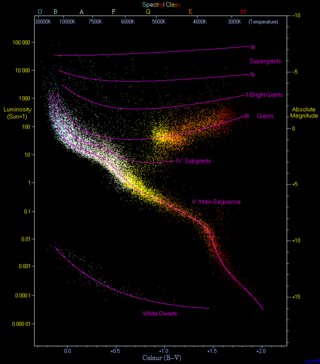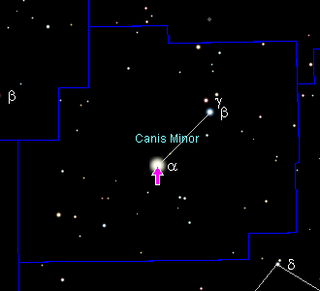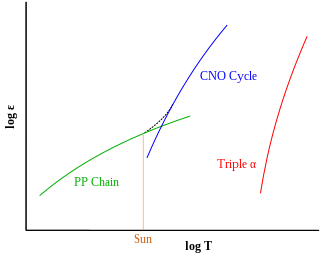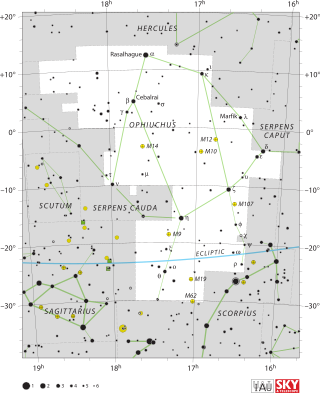Related Research Articles

In astronomy, the main sequence is a classification of stars which appear on plots of stellar color versus brightness as a continuous and distinctive band. Stars on this band are known as main-sequence stars or dwarf stars, and positions of stars on and off the band are believed to indicate their physical properties, as well as their progress through several types of star life-cycles. These are the most numerous true stars in the universe and include the Sun. Color-magnitude plots are known as Hertzsprung–Russell diagrams after Ejnar Hertzsprung and Henry Norris Russell.

Procyon is the brightest star in the constellation of Canis Minor and usually the eighth-brightest star in the night sky, with an apparent visual magnitude of 0.34. It has the Bayer designation α Canis Minoris, which is Latinized to Alpha Canis Minoris, and abbreviated α CMi or Alpha CMi, respectively. As determined by the European Space Agency Hipparcos astrometry satellite, this system lies at a distance of just 11.46 light-years, and is therefore one of Earth's nearest stellar neighbors.

Stellar evolution is the process by which a star changes over the course of time. Depending on the mass of the star, its lifetime can range from a few million years for the most massive to trillions of years for the least massive, which is considerably longer than the current age of the universe. The table shows the lifetimes of stars as a function of their masses. All stars are formed from collapsing clouds of gas and dust, often called nebulae or molecular clouds. Over the course of millions of years, these protostars settle down into a state of equilibrium, becoming what is known as a main-sequence star.

Stellar nucleosynthesis is the creation (nucleosynthesis) of chemical elements by nuclear fusion reactions within stars. Stellar nucleosynthesis has occurred since the original creation of hydrogen, helium and lithium during the Big Bang. As a predictive theory, it yields accurate estimates of the observed abundances of the elements. It explains why the observed abundances of elements change over time and why some elements and their isotopes are much more abundant than others. The theory was initially proposed by Fred Hoyle in 1946, who later refined it in 1954. Further advances were made, especially to nucleosynthesis by neutron capture of the elements heavier than iron, by Margaret and Geoffrey Burbidge, William Alfred Fowler and Fred Hoyle in their famous 1957 B2FH paper, which became one of the most heavily cited papers in astrophysics history.

Red supergiants (RSGs) are stars with a supergiant luminosity class of spectral type K or M. They are the largest stars in the universe in terms of volume, although they are not the most massive or luminous. Betelgeuse and Antares A are the brightest and best known red supergiants (RSGs), indeed the only first magnitude red supergiant stars.

Mira variables are a class of pulsating stars characterized by very red colours, pulsation periods longer than 100 days, and amplitudes greater than one magnitude in infrared and 2.5 magnitude at visual wavelengths. They are red giants in the very late stages of stellar evolution, on the asymptotic giant branch (AGB), that will expel their outer envelopes as planetary nebulae and become white dwarfs within a few million years.

CoRoT was a space telescope mission which operated from 2006 to 2013. The mission's two objectives were to search for extrasolar planets with short orbital periods, particularly those of large terrestrial size, and to perform asteroseismology by measuring solar-like oscillations in stars. The mission was led by the French Space Agency (CNES) in conjunction with the European Space Agency (ESA) and other international partners.

In astronomy, a blue giant is a hot star with a luminosity class of III (giant) or II. In the standard Hertzsprung–Russell diagram, these stars lie above and to the right of the main sequence.

A blue supergiant (BSG) is a hot, luminous star, often referred to as an OB supergiant. They have luminosity class I and spectral class B9 or earlier.

Asteroseismology is the study of oscillations in stars. Stars have many resonant modes and frequencies, and the path of sound waves passing through a star depends on the speed of sound, which in turn depends on local temperature and chemical composition. Because the resulting oscillation modes are sensitive to different parts of the star, they inform astronomers about the internal structure of the star, which is otherwise not directly possible from overall properties like brightness and surface temperature.
Helioseismology, a term coined by Douglas Gough, is the study of the structure and dynamics of the Sun through its oscillations. These are principally caused by sound waves that are continuously driven and damped by convection near the Sun's surface. It is similar to geoseismology, or asteroseismology, which are respectively the studies of the Earth or stars through their oscillations. While the Sun's oscillations were first detected in the early 1960s, it was only in the mid-1970s that it was realized that the oscillations propagated throughout the Sun and could allow scientists to study the Sun's deep interior. The modern field is separated into global helioseismology, which studies the Sun's resonant modes directly, and local helioseismology, which studies the propagation of the component waves near the Sun's surface.

A giant star, also simply a giant, is a star with substantially larger radius and luminosity than a main-sequence star of the same surface temperature. They lie above the main sequence on the Hertzsprung–Russell diagram and correspond to luminosity classes II and III. The terms giant and dwarf were coined for stars of quite different luminosity despite similar temperature or spectral type by Ejnar Hertzsprung about 1905.

The asymptotic giant branch (AGB) is a region of the Hertzsprung–Russell diagram populated by evolved cool luminous stars. This is a period of stellar evolution undertaken by all low- to intermediate-mass stars (about 0.5 to 8 solar masses) late in their lives.

The red-giant branch (RGB), sometimes called the first giant branch, is the portion of the giant branch before helium ignition occurs in the course of stellar evolution. It is a stage that follows the main sequence for low- to intermediate-mass stars. Red-giant-branch stars have an inert helium core surrounded by a shell of hydrogen fusing via the CNO cycle. They are K- and M-class stars much larger and more luminous than main-sequence stars of the same temperature.

A subgiant is a star that is brighter than a normal main-sequence star of the same spectral class, but not as bright as giant stars. The term subgiant is applied both to a particular spectral luminosity class and to a stage in the evolution of a star.

Epsilon Ophiuchi or ε Ophiuchi, formally named Yed Posterior, is a red giant star in the constellation of Ophiuchus. Located less than five degrees south of the celestial equator in the eastern part of the constellation, it forms a naked eye optical double with Delta Ophiuchi. With an apparent visual magnitude of 3.220, the star can be seen with the naked eye from most of the Earth under suitably dark skies. Parallax measurements yield an estimated distance of 106.4 light-years from the Sun.
Solar-like oscillations are oscillations in stars that are excited in the same way as those in the Sun, namely by turbulent convection in its outer layers. Stars that show solar-like oscillations are called solar-like oscillators. The oscillations are standing pressure and mixed pressure-gravity modes that are excited over a range in frequency, with the amplitudes roughly following a bell-shaped distribution. Unlike opacity-driven oscillators, all the modes in the frequency range are excited, making the oscillations relatively easy to identify. The surface convection also damps the modes, and each is well-approximated in frequency space by a Lorentzian curve, the width of which corresponds to the lifetime of the mode: the faster it decays, the broader is the Lorentzian. All stars with surface convection zones are expected to show solar-like oscillations, including cool main-sequence stars, subgiants and red giants. Because of the small amplitudes of the oscillations, their study has advanced tremendously thanks to space-based missions.

A red giant is a luminous giant star of low or intermediate mass in a late phase of stellar evolution. The outer atmosphere is inflated and tenuous, making the radius large and the surface temperature around 5,000 K or lower. The appearance of the red giant is from yellow-white to reddish-orange, including the spectral types K and M, sometimes G, but also class S stars and most carbon stars.
Yvonne Elsworth FRS FInstP FRAS is an Irish physicist, Professor of Helioseismology and Poynting Professor of Physics in the School of Physics and Astronomy at the University of Birmingham. Elsworth was until 2015 also the Head of the Birmingham Solar Oscillations Network (BiSON), the longest running helioseismology network with data covering well over three solar cycles.

A gas giant is a giant planet composed mainly of hydrogen and helium. Gas giants are also called failed stars because they contain the same basic elements as a star. Jupiter and Saturn are the gas giants of the Solar System. The term "gas giant" was originally synonymous with "giant planet". However, in the 1990s, it became known that Uranus and Neptune are really a distinct class of giant planets, being composed mainly of heavier volatile substances. For this reason, Uranus and Neptune are now often classified in the separate category of ice giants.
References
- ↑ Chaplin, W.J.; Miglio, A. (August 2013), "Asteroseismology of Solar-Type and Red-Giant Stars", Annual Review of Astronomy and Astrophysics, 51 (1): 353–392, arXiv: 1303.1957 , Bibcode:2013ARA&A..51..353C, doi:10.1146/annurev-astro-082812-140938, S2CID 119222611
- ↑ Bedding, Timothy R.; et al. (2011). "Gravity modes as a way to distinguish between hydrogen- and helium-burning red giant stars". Nature . 471 (7340): 608–11. arXiv: 1103.5805 . Bibcode:2011Natur.471..608B. doi:10.1038/nature09935. PMID 21455175. S2CID 4338871.
- ↑ Professor Tim Bedding - Staff Profile at the University of Sydney
- ↑ History of the University of Sydney School of Physics
- ↑ Academics recognised for leadership, teaching and research impact
- ↑ "Guest Speaker - Prof Tim Bedding (University of Sydney) - SASI". www.sasi.net.au.
- ↑ "National Team Results". afda.com. Australian Flying Disc Association.
- ↑ "Tim Bedding". Australian Academy of Science. Retrieved 25 May 2020.